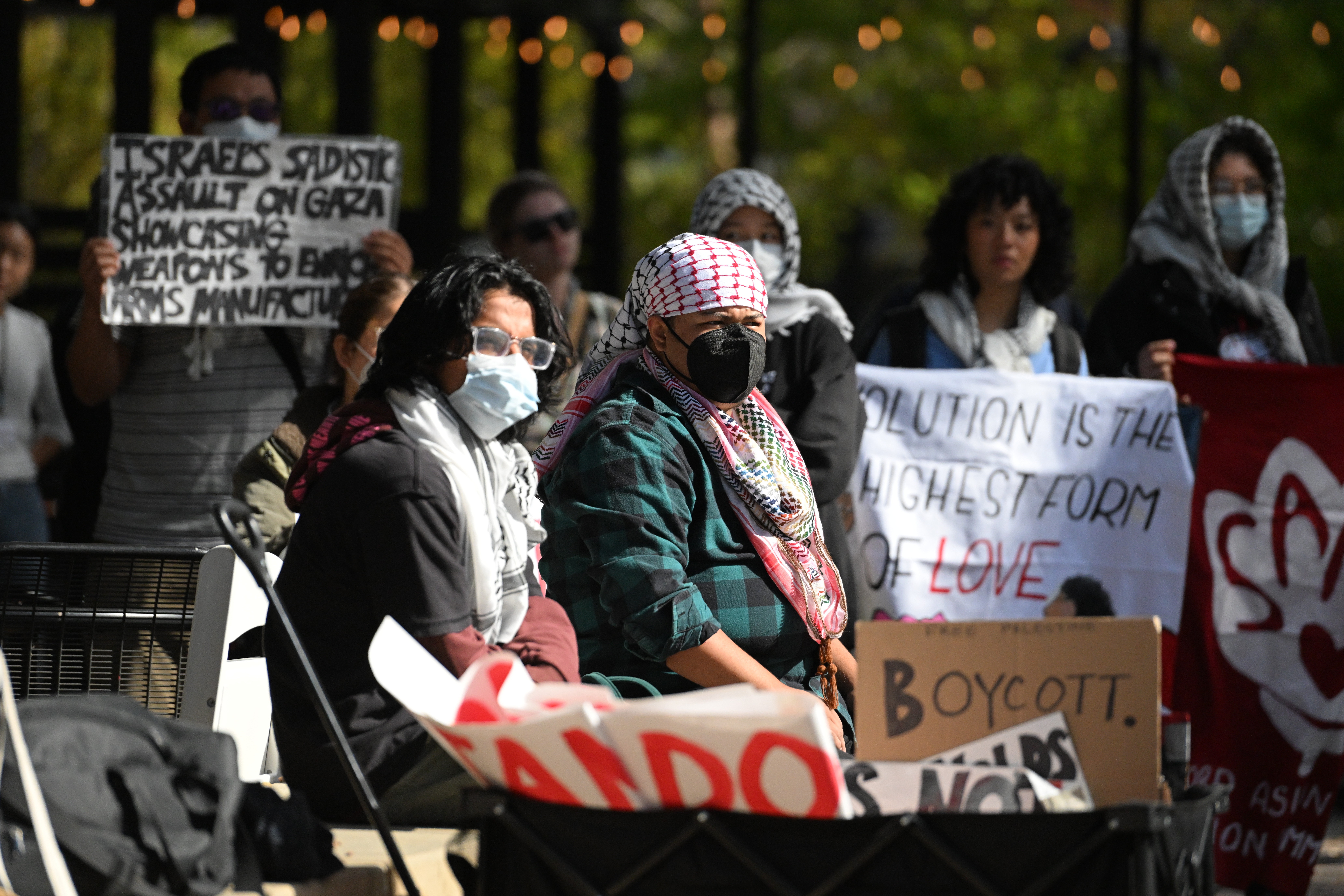Nearly 50 people gathered in White Plaza Monday to hold a “people’s tribunal” against the University, protesting disciplinary proceedings against pro-Palestine students who occupied the president’s office in June. Demonstrators also condemned the Board of Trustees’ refusal to divest from companies tied to the Israel Defense Forces.
The protest came on the same day as an Office of Community Standards (OCS) hearing for eight students who participated in the June 5 takeover of Building 10, the president’s office, in Main Quad. The occupation led to 13 arrests, including of a Daily reporter, as well as suspensions and bans from campus. Pro-Palestine activist groups on campus have since referred to the arrested students as the “Stanford 13,” calling for the University to drop its disciplinary charges against them.
“It has become unquestionably evident that this genocide is happening with the active participation of the United States and substantial financial backings by Stanford University,” said one speaker at the protest who identified themselves only as a master’s student. “As we speak, Stanford students who protested against genocide on June 5 are currently undergoing their disciplinary time.”
Student speakers especially criticized a recent decision by the University Board of Trustees’ Special Committee on Investment Responsibility (SCIR) to take no action on an SJP petition that called for the University to divest from companies tied to the Israel Defense Forces. The SCIR cited the “avoidance of institutional orthodoxy” as a rationale in its letter delivering the decision.
Stanford Students for Justice in Palestine (SJP) announced Monday’s protest in an Instagram post that stated, “Stanford is guilty, not the 13.”
The demonstration took the format of a “people’s tribunal,” in which student speakers assumed the role of “witnesses” to the University’s alleged complicity in Israeli war crimes.
Many students at the demonstration wore keffiyehs and face masks. On stage, a banner spelled out “Stanford On Trial” alongside a blood-soaked gavel and dozens of handprints.
Echoing the “tribunal” theme of the demonstration, protesters also placed a cardboard cutout of University president Jonathan Levin ’94 onstage, with a sign draped over his neck which read “GUILTY.” One speaker referred to the president as “lying, lifeless Levin.”

Another speaker read out a statement that they claimed to be from one of the protesters who has remained banned from campus since occupying Building 10. “I regret that I am unable to be with you all in person,” the unnamed statement read, going on to condemn the Board of Trustees as “among some of the most dangerous people on this planet” for the University’s stance on the war.
The Daily has reached out to the University for comment.
Several University administrators were present at the periphery of the event, wearing lanyards that included their names and identified them as University agents. Kathy Veit, a managing director for principal gifts in the Office of Development, told The Daily that University staff were present to make sure that demonstrators followed the University’s speech policies.
Snehal Naik, senior director of the Office of Student Engagement, said University administrators were present to “observe” the rally. In response to a question from The Daily, he did not specify any connection between the political message of the demonstration and the presence of University staff.
Joanna Baker ’25, who was present at White Plaza, told The Daily that growing up in the “shadow of the Holocaust” has driven her involvement in Stanford Jewish Voice for Peace, a Jewish anti-Zionist organization.
“As we learn these stories in our childhood, we all ask the question, ‘Why didn’t anyone do anything to stop it?’” Baker said. “These questions were answered with propaganda to get us to believe that taking other people’s land is what is necessary to keep us safe.”
Arielle Johnson, who recently began as a bioengineering postdoctoral student at Stanford, noted a “slightly larger activism movement around Palestine” at her previous institution, Cornell. At both universities, however, she said many students may “feel like they have a lot to lose” by publicly engaging in pro-Palestinian activism.
“I’m scared too, but I’m here because I still have my life and my health,” Johnson said. “I’m in a situation where I’m able to come here and do an academic job, and that’s not true for the people in Gaza.”
A Lebanese undergraduate student, who identified herself only as Hannah, spoke about the impact of Israeli forces in Lebanon, highlighting the bombing of civilian areas. Israel expanded a ground invasion and airstrikes on Lebanon in early October, escalating a longstanding conflict with Hezbollah, an Islamist militant organization and Lebanese political party.
“My grandfather brought strawberries to Lebanon. He was a farmer. My dad and my uncles all worked there and spent their lives there, and now, where is it?” Hannah said. “All of these amazing institutions that are built into our families are gone.”
A protester told The Daily that undercover police officers were present at the protest. The Daily was unable to corroborate those claims and has reached out to the Stanford University Department of Public Safety (SUDPS) for comment. The Daily has also reached out to the University concerning the presence of private security groups at the protest.
The Santa Clara County Sheriff’s Office and the Santa Clara Police Department (SCPD) both wrote to The Daily that they were not involved in the protest Monday.
This article has been updated with comment from the Santa Clara County Sheriff’s Office and the SCPD.
A previous version of this article misrepresented Arielle Johnson’s quote. The Daily regrets this error.
